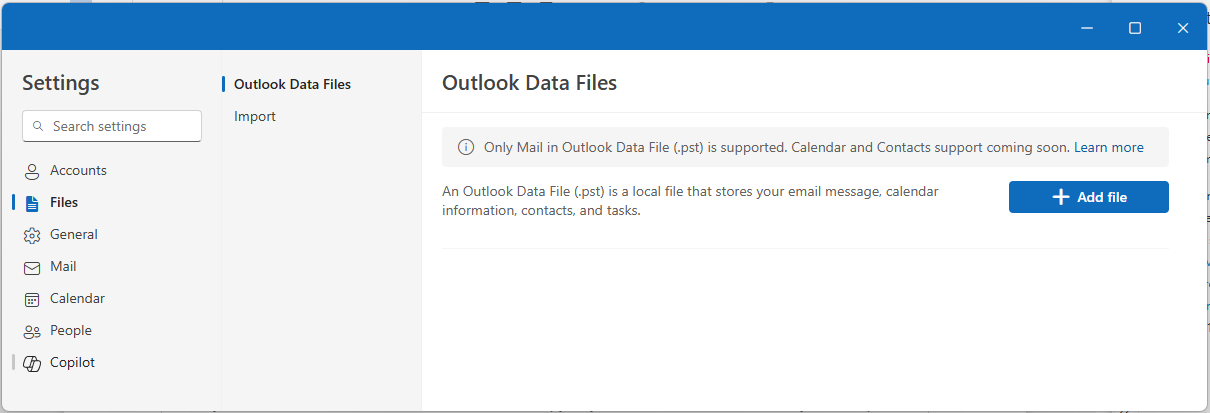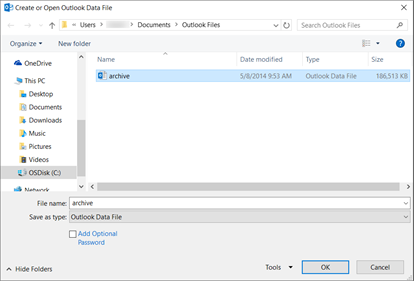Outlook Data Files (.pst), or Personal Storage Tables files, contain Outlook user messages and other Outlook items, such as contacts, appointments, tasks, notes, and journal entries. You might also use an Outlook data file to backup messages or store older items locally on your computer to keep the size of your mailbox small.
We currently provide different levels of support for Outlook Data Files, depending on which version of Outlook you are using. To determine which version of Outlook you're using, look for the word Outlook on the top app bar. If you only see the Outlook icon, you're using classic Outlook. If the product name is next to the Outlook icon, you're using new Outlook.
Outlook Data File (.pst) support in new Outlook
You can move, copy, and delete emails and folders in your .pst file. You can also drag and drop emails between your mailbox and .pst files. The latest update now includes the ability to export emails, calendars, contacts, and tasks from a mailbox to a .pst file. We planto release support for bulk importing Mail, Calendar, and Contacts from a PST into a Mailbox. We will also remove the requirement that users need to have classic Outlook installed to use PSTs in new Outlook. After that we have no further investments planned.
For more details see: Export emails, contacts, and calendar items to Outlook using a .pst file.
Open an Outlook Data File (.pst) in new Outlook
You can open .pst files, read e-mails in .pst files, and search .pst files for emails.
-
To open an Outlook Data File (.pst), go to Settings > Files > Outlook Data Files.
-
Select Add file.
-
Select a .pst file and then select Open.
Requirements
To open .pst files in new Outlook, note the following requirements:
-
Opening .pst files in new Outlook requires classic Outlook to also be installed. Both versions need to be the same architecture: 32-bit (x86) or 64-bit (x64).
|
If you have... |
You need... |
|
|---|---|---|
|
64-bit machine |
64-bit classic Outlook and 64-bit new Outlook |
|
|
32-bit machine |
32-bit classic Outlook and 32-bit new Outlook |
Important: Before installing a different version of Outlook – 32-bit (x86) or 64-bit (x64) – make sure you uninstall the previous version. Learn more at Choose between the 64-bit or 32-bit version of Office.
Note: The new Outlook for Windows app updates automatically to the version that matches the machine architecture (64-bit or 32-bit). Learn more at Manage updates in new Outlook for Windows.
-
The account you're using in new Outlook must have a Microsoft 365 subscription.
-
If your subscription is from a Microsoft account with a third-party email address, such as Gmail or Yahoo, see Connecting a subscription purchased with a Microsoft account to Outlook.
-
-
Outlook Data Files (.pst) isn't supported with the ARM version of new Outlook.
-
New Outlook cannot be in Safe or Recovery modes.
Open an Outlook Data File (.pst) in classic Outlook
If you use a POP or IMAP account, then all of your Outlook information is stored in an Outlook data file, also known as a Personal Storage Table (.pst) file.
By default, when you use classic Outlook's search tools, Outlook only searches the current mailbox. Any additional Outlook data files stored on your computer won't be searched unless you change your search scope to All Mailboxes.
You might also have an Outlook data file if you use AutoArchive with your Exchange server email account. This is a different feature than Archive button in Outlook 2016. For more information, see Archive in Outlook 2016. To see what your AutoArchive settings and location are, and for instructions to turn off AutoArchive, see Automatically move or delete older items with AutoArchive.
Open an Outlook Data File in classic Outlook
In order for Outlook to search a Personal Folders file for a specific word or phrase or sender, the file must be open in Outlook.
-
In classic Outlook, choose File > Open & Export > Open Outlook Data File.
-
Choose the Outlook data file you want to open.
-
Expand the top level of the Outlook data file in the Outlook Navigation pane to see the subfolders in the file. Click each subfolder to see the contents.
-
To search for a specific email, use Outlook's built-in search tools.
-
If you want to import your archived items back into your Inbox, follow the instructions for importing a .pst file.
Find your .pst file
In Outlook 2016 and newer versions, new Outlook data files are, by default, saved in the following locations:
-
Windows 10 drive:\Users\user\Documents\Outlook Files\archive.pst
In earlier versions of Outlook, the archive file is saved in the following locations:
-
Windows 10 drive:\Users\user\AppData\Local\Microsoft\Outlook\archive.pst
Related topics
Switch to another Outlook e-mail profile













